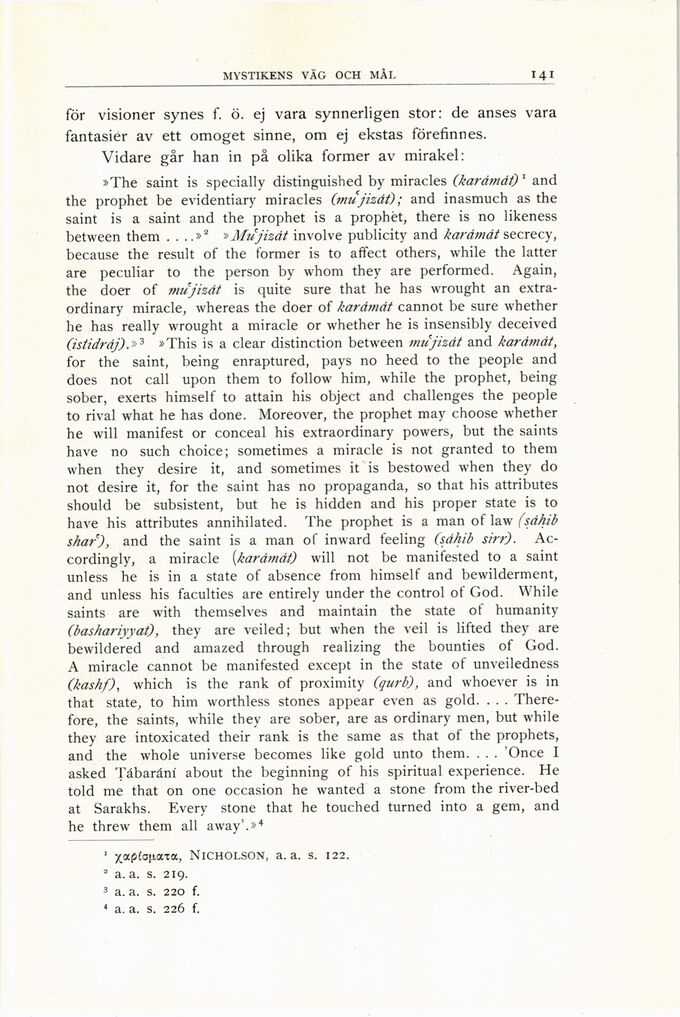
Full resolution (JPEG) - On this page / på denna sida - Sigurd Lindquist, Mystikens väg och mål - II. Det mystiska tillståndet och dess innehåll - A. Positiva fenomen närmast tillhörande sensibilitetens och motilitetens område

<< prev. page << föreg. sida << >> nästa sida >> next page >>
Below is the raw OCR text
from the above scanned image.
Do you see an error? Proofread the page now!
Här nedan syns maskintolkade texten från faksimilbilden ovan.
Ser du något fel? Korrekturläs sidan nu!
This page has never been proofread. / Denna sida har aldrig korrekturlästs.
MYSTIKENS VÄG OCH MÅL
I 29
för visioner synes f. ö. ej vara synnerligen stor: de anses vara
fantasier av ett omoget sinne, om ej ekstas förefinnes.
Vidare går han in på olika former av mirakel:
»The saint is specially distinguished by miracles (karämdt)1 and
the prophet be evidentiary miracles Cmujizdt); and inasmuch as the
saint is a saint and the prophet is a prophèt, there is no likeness
between them . . ..»2 »Mujizdt involve publicity and karämdt secrecy,
because the result of the former is to affect others, while the latter
are peculiar to the person by whom they are performed. Again,
the doer of mujizdt is quite sure that he has wrought an
extra-ordinary miracle, whereas the doer of karämdt cannot be sure whether
he has really wrought a miracle or whether he is insensibly deceived
Cistidrd):).»3 »This is a clear distinction between mujizdt and karämdt,
for the saint, being enraptured, pays no heed to the people and
does not cail upon them to follow him, while the prophet, being
sober, exerts himself to attain his object and challenges the people
to rival what he has done. Moreover, the prophet may choose whether
he will manifest or conceal his extraordinary powers, but the saints
have no such choice; sometimes a miracle is not granted to them
when they désiré it, and sometimes it is bestowed when they do
not désiré it, for the saint has no propaganda, so that his attributes
should be subsistent, but he is hidden and his proper state is to
have his attributes annihilated. The prophet is a man of law (sdhib
skar), and the saint is a man of inward feeling (sdhib sirr).
Ac-cordingly, a miracle [karämdt) will not be manifested to a saint
unless he is in a state of absence from himself and bewilderment,
and unless his faculties are entirely under the control of God. While
saints are with themselves and maintain the state of humanity
(bashariyyat), they are veiled; but when the veil is lifted they are
bewildered and amazed through realizing the bounties of God.
A miracle cannot be manifested except in the state of unveiledness
(kashf), which is the rank of proximity (qurb), and whoever is in
that state, to him worthless stones appear even as gold. . . .
There-fore, the saints, while they are sober, are as ordinary men, but while
they are intoxicated their rank is the same as that of the prophets,
and the whole universe becomes like gold unto them. . . . ’Once I
asked Tåbaråm about the beginning of his spiritual experience. He
told me that ön one occasion he wanted a stone from the river-bed
at Sarakhs. Every stone that he touched turned into a gem, and
he threw them all away’.»4
* xaPfo(iaTa, Nicholson, a. a. s. 122.
2 a. a. s. 219.
3 a. a. s. 220 f.
4 a. a. s. 226 f.
<< prev. page << föreg. sida << >> nästa sida >> next page >>